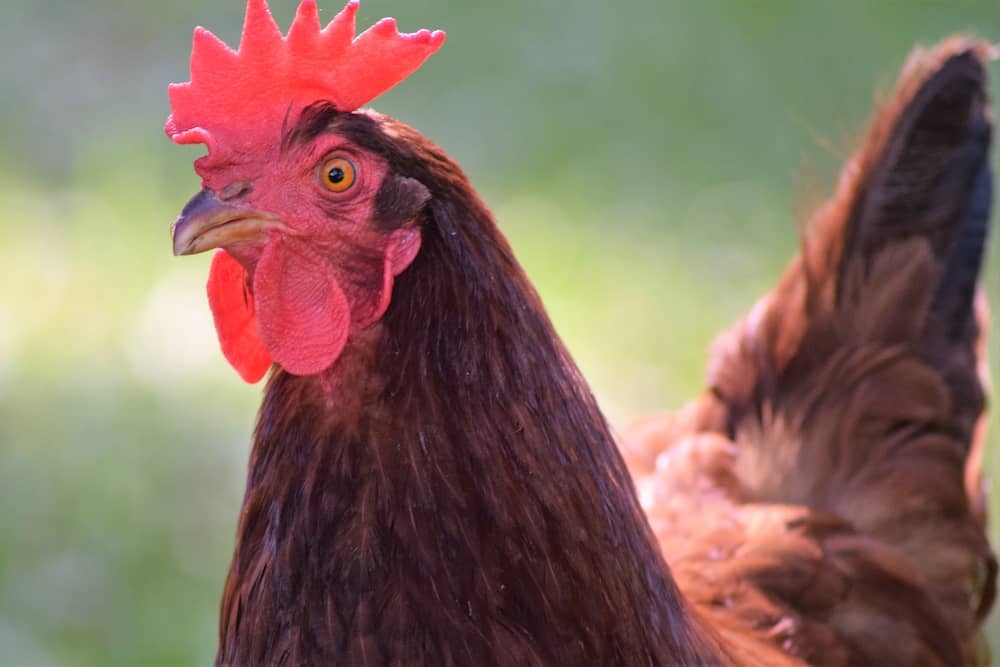Raising Rhode Island Red chickens is a great way to have a reliable source of eggs and meat. They are easy to care for and can be raised in small spaces. This breed is ideal for beginners and is generally robust and healthy. If you want lots of eggs, RIRs are a great choice.
Rhode Island Reds were initially bred as dual-purpose birds, making their qualities more utilitarian in nature instead of aesthetical.
Learn what to know about RI Reds and what it takes to raise them properly. I’ll explain important characteristics, including their origin and history, temperament, lifespan, egg production, size, and other factors.
Rhode Island Red
The story behind this chicken breed goes way back to the mid-1800s when a ship captain acquired a rooster from his fellow sailor and proceeded to breed it with his chickens. The captain, who went by the name of William Tripp, then noticed that the offspring of these particular unions tended to lay more eggs.
After enlisting the help of a certain John Macomber, Captain Tripp began cross-breeding to a greater extent. The resulting chickens, which were either given the name Macomber or Tripp’s Fowl, were noted to be superior in several departments compared to the already existing local fowl.
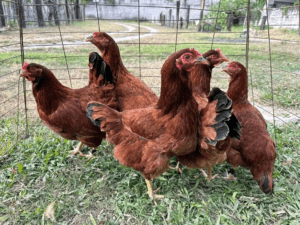
Eventually, the duo started putting their work into designing the ideal Rhode Island Red hen. The venture included the introduction of several breeds into the mix, including the Plymouth Rock chicken, Brown Leghorn, Light Brahma, Chinese Cochin, Java, and Malay.
Once this caught the attention of the already-renowned poultry man Isaac Wilbour, he purchased some of the breeds to begin his program.
He eventually got sole credit for naming the breed the Rhode Island Red despite the efforts put in by Macomber and Tripp. As far as appearance today, Rhode Island chickens sometimes resembles the Isa Brown chicken.
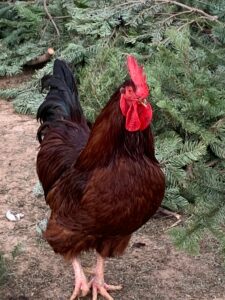
How Big Do Rhode Island Reds Get?
It was in the year 1904 when the American Poultry Association started recognizing the Rhode island red chicken as an official chicken breed. They described the fowls as large and clean-legged.
Five years later, in 1909, the British Poultry Standard followed suit, addressing the breed with the same kind of recognition as their American counterpart.
Body
This type of chicken should have a solid and rectangular body, with feathers that are hard due to their Java and Malay heritage. Colors that describe the “perfect” chicken have changed over the years, from the rich mahogany shade that used to be so popular to the dark rust color coveted by breeders today.
Black feathers can also appear in the tail and wing portion, which is normal but is considered by APA judges to “dirty” the appearance of the animal. The bird should be yellow-skinned, with red or orange eyes and red ear lobes, wattles, and comb. It should also have four toes in each foot and a yellowish beak.
The comb can differ among Rhode Islands, with most generally having a single, upright comb and a select few described as being rose-combed. (Other similar-looking chickens are Production Reds. They are lighter in color and crossed with White Leghorns to produce the California Tan chicken.)
Weight
This breed also varies in terms of size, from the smaller, less popular bantam chickens to the bigger Rhode Island Red hen and Rhode Island Red rooster, which can weigh 6.5 lbs and 8.5 lbs, respectively.
Those of the rose comb variety tend to weigh slightly less than their upright comb counterparts. As for those classified as bantams, the hen can weigh a smidge under two pounds and the rooster just a tiny bit above it.
Are Rhode Island Reds Friendly?
RI Red chickens can be quiet and easy to manage, but they can also be noisy and pushy. According to many experienced breeders, they are lively, friendly, and curious. Plus, you can even grow to love their pushy attitude.
As far as the pecking order is concerned, this breed is smack right in the middle.
It is the type of chicken that forage actively, scavenging for seeds and insects while occasionally going for the frogs or mice that come their way.
These chickens aren’t averse to confinement but would love nothing more than to have the freedom to investigate their entire surroundings for some tasty morsels.
Broodiness in Rhode Island hens has since been suppressed by the breeding and selection process. However, on the rare occasions this characteristic surfaces, it tends to make hens better mothers.
Broody hens are not only more diligent about sitting on their nests but are also more protective of their chicks. The hens are typically the most laid back of the bunch and the least known to cause any trouble.
Rhode Island Red Rooster
The Rhode Island Red rooster, on the other hand, can be the exact opposite, displaying aggression toward chickens and people alike. When selecting roosters, make it a point to choose the least aggressive of the group.
RI Red chickens have gotten a bad reputation over the years thanks to overly aggressive roosters. Of course, this doesn’t necessarily mean all roosters will be hostile toward you and other birds. You can still get lucky and land one that has a calm and docile temperament.
Also when raising roosters of any breed, be sure to have a minimum of 10 hens per rooster. That will go a long way toward keeping the flock safe and the stress level minimized.
How Many Eggs Does a Rhode Island Red Lay a Day?
Egg-laying is among the areas that Rhode Islands excel at; it’s hard to find any fowl that can surpass them in this department.
Whether it’s output or continuity, no chicken breed can outdo the Rhode Island hen. Along with ISA Brown chicken, RI Red hens are one of the best egg laying chickens.
Hens were originally developed to be dual purpose, but in the 1940s, the breed underwent some refinement to have better egg production. It was during this point when it was split into the categories of industrial and heritage.
The Rhode Island Red hens that we see in chicken coops today were bred from the better egg-laying variety. They generally start laying eggs at 18 to 20 weeks, though some can lay as early as 16 weeks.
A healthy hen can lay up to 300 eggs a year, although many breeders will aim for the more modest goal of 150 to 250 eggs.
Generally, hens will lay five to six eggs per week. These eggs could range from medium to large and are light brown. Eventually, as your hens increase in size, so will their eggs.
Now, we have the heritage hen, which doesn’t fall too far back in the best egg-laying category but does have poorer quality eggs as well as meat taste and texture.
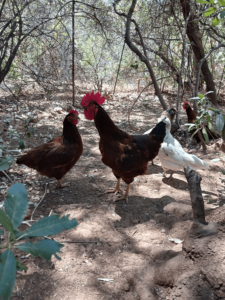
How Long Do Rhode Island Reds Live?
Rhode Islands are robust, pushy, and talkative birds. They are also among the most prolific egg layers. They are split into two categories, with the more common one being the “production” line.
Chickens belonging to the “heritage” line have a genetic makeup that has remained mostly unchanged since their creation.
Know that much of their lifespan depends on their care. When provided with adequate care and nutrition, Rhode Islands can live for more than 8 years.
Factors that Affect Life Expectancy
Aside from diet and nutrition, other factors affect the life expectancy of a RI Red chicken, including housing, diseases, veterinary care, genetics, and the environment.
1. Housing
The old way of housing chickens doesn’t bode too well for your flock’s health. When housed with other animals, chickens run the risk of being trampled on, getting frozen to death, and contracting various diseases.
These days, proper chicken housing comes in the form of well-built backyard coops designed for keeping a flock warm during winter and cool during the summer.
The best chicken coops shelter chickens from harsh weather conditions and keep them safe from predators. With coops, chickens can live freely and improve their physical and mental state, which is key to having a longer lifespan.
2. Diseases
Birds don’t have the strongest immune system, so proper preventative measures have to be observed when raising them. It’s important to keep your flock safe from mites, lice, and worms that could impact their health severely. These parasites can cause anything from anemia and skin irritation to a painful death.
To protect your flock’s health, make sure to perform preventative actions such as worming and dusting as frequently as your management style allows. Inspect the coop every week to see how your chickens are doing. Keep it clean.
While there are still diseases beyond your control, implementing careful management means you can contain viral illnesses effectively and keeping common chicken diseases from spreading.
3. Veterinary Care
For many years, people barely paid any attention to the health and well-being of hens. These days, tremendous progress has been made in that regard, with breeders now having more understanding about the disease and wellness problems that affect flocks.
There are now veterinarians who specialize in poultry. You can partner with these professionals to take better care of your flock and improve their lifespan.
In the process, you acquire more knowledge about caring for your chickens’ feet, removing bumbles, administering medication, and even stitching up wounds.
4. Environment
As far as climate is concerned, Rhode Island Red chickens are considered to be fairly heat tolerant and cold hardy. They are considered to be ideal for backyards.
The condition of the coop or wherever you happen to be keeping your flock in will ultimately affect the chicken’s long-term health. The ideal coop should be clean, dry, and warm, and have adequate water and food. Flocks kept in filthy environments with barely enough food and little protection are not expected to live long.
5. Genetics
It has been mentioned that breeding can be manipulated in a way that affects egg production. However, this process can be detrimental to a species’ long-term survival.
It can be especially tricky when the breed in question happens to have a tiny genetic pool. Sometimes, interbreeding is taken too far among a particular species that it puts its lifespan at risk.
Good breeding means introducing unrelated lines to expand the gene pool and create as little problems as possible for the breed. Working to bring diversity within a species, though, is costly and complicated. This also tends to result in disappointments and failures.
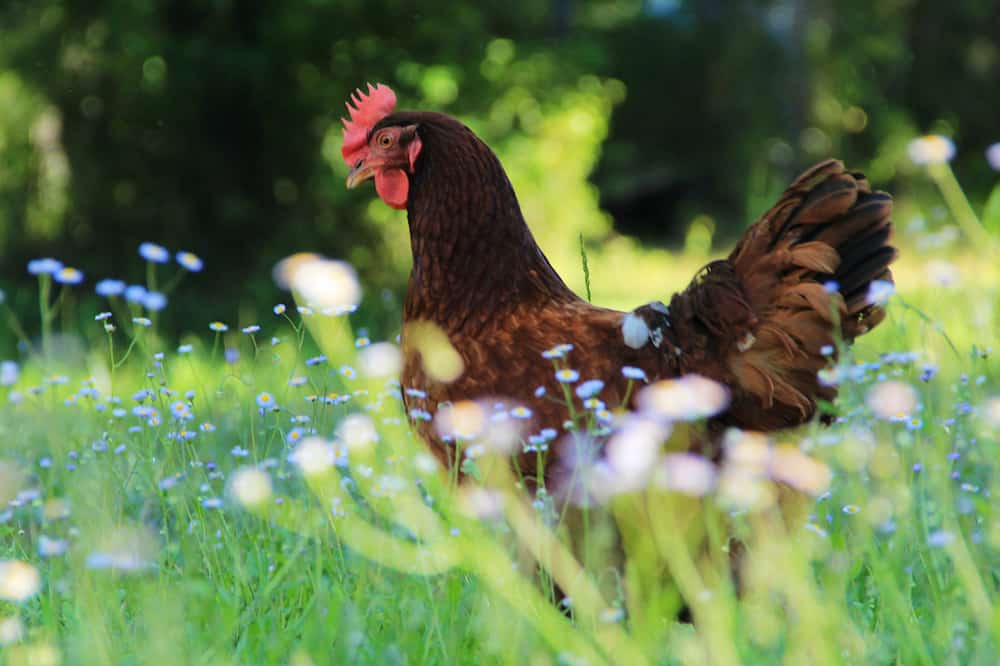
Health Issues to Keep in Mind
Rhode Islands are as robust as chickens can get, but that doesn’t mean they aren’t prone to some health issues. Ectoparasites, such as mites, can still be a problem for these birds. You can keep them at bay with proper preventative measures like regular inspection, dusting, and careful management.
Aside from these potential health issues, RI Reds are generally a healthy and active breed that anyone who’s fond of raising chickens would love to have in their coop.
Why Choose Rhode Island Red?
Here are some considerations you need to look at before going for this breed:
1. Chicken’s Characteristic
These chickens come in a gorgeous reddish-brown color, are incredibly docile, and enjoy being around people and other chickens. RI Reds don’t demand too much of you in the care department. They’ll be quite content to live on the proper chicken feed and layer feed for laying hens. Provide opportunities for free ranging along with chicken scratch.
You’ll also have a relatively easy time as far as accommodations go.
While adversity is something other breeds will succumb to, for some reason, the Rhode Islands will relish it. This breed is a survivor through and through, with the immune system to back it up.
Like the Golden Comet chicken, they have an easy-going attitude and high-tolerance level that you’ll enjoy. They’re a lot like domesticated dogs in this regard, following their owners around in the hopes of being thrown a treat.
Roosters, though, are a different story. They are not as family-oriented as the rest of the flock. Unlike the hens, they can be aggressive and should be kept away from children.
2. What You’ll Get From It
If hens that lay dozens of eggs is what you’re going for, then this breed has got you covered. RI Red hens are an excellent food source, not just because of the number of eggs they produce but also because of the texture and taste of their meat.
That said, for birds bred for meat consumption, yellow skin is an undesirable trait. For this reason, most of the chicken you buy in supermarkets or grocery stores are unlikely to have yellow skin.
Seeing as Rhode Islands have exactly this type of skin, they won’t likely make the cut in most meat shops. They aren’t considered to be a meat breed.
3. Good for Beginners
They will generally suit anyone interested in raising chickens even if they don’t quite know what breed to decide on. With Rhode Islands, there’s hardly anything that can go wrong.
This breed is perfect for getting you adjusted to the lifestyle, especially if you’re someone who’s just getting into raising chickens. RIR chickens can be in a mixed breed with other mild-mannered chickens such as Plymouth Rock chickens.
4. The Needs of the Chicken
Unlike other breeds with very particular needs that can stress you out, this one won’t demand too much from you in most departments.
There’s a reason why these birds are popular all over the world. This mainly has to do with how easily they can acclimate to any condition, from the intense, dry heat of Australia to the colder, chillier atmosphere of Canada.
It doesn’t matter what kind of weather conditions you’re dealing with; this breed is guaranteed to take things in stride. The climate aside, you still have to make sure you provide suitable accommodation and care to your flock.
While they generally would be able to handle the cold or heat, you need to keep them in a properly-equipped environment that makes it easier for them to do so.
Rhode Islands also have a knack for avoiding predators. They tend to be so in tune with their surroundings while foraging for food that almost nothing can catch them off guard.
Thus, these chickens can still thrive in a free-range environment. In this situation, though, you’ll find it incredibly tough to find their eggs.
Hens will typically look for the best place to lay their eggs, and, most of the time, it won’t be in the nesting box. What to Feed Baby Chickens
Summary
The poultry world wouldn’t be what it is today without the RI red chicken. It’s a prolific egg layer with loads of attitude and a no-stress personality. It gives you the world without asking for much in return except for adequate care and accommodation.
They are an ideal choice for people who want to try raising chickens for the first time.
Rhode Island Hens
The hens, especially, are quite the character. As assertive as they are, which makes them great mothers, they aren’t aggressive and are great around children and other chickens. These chickens will immediately run to your side or follow you around, expecting a treat, which makes them really fun to have in the backyard.
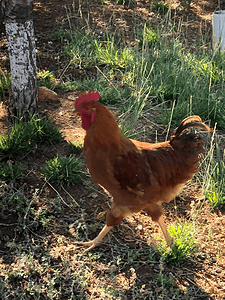
Rhode Island Roosters
Then, we have the RI rooster, which is at the opposite end of the spectrum as far as attitude is concerned and requires a little more thought when choosing. When picking one, opt for a less aggressive male who will give you much less trouble with your job. If you’re lucky enough to find a sweet and healthy rooster, you’re definitely on your way to forming the ideal flock!
Benefits of Rhode Island Red chickens
Your flock of Rhode Island Red chickens is guaranteed to give you a ton of benefits. Watch as they do a cleanup drive in your backyard, getting rid of seeds and insects effectively.
If you happen to be new to the whole chicken-raising venture, the best choice you could ever make is to purchase some of these chickens.
Not only will this breed make it easier for you to raise chickens, but it will also make you love doing it! If you are interested in a prolific egg layer to raise alongside your Rhode Island Reds, consider the Cinnamon Queen chicken which was bred using RI Red males.

